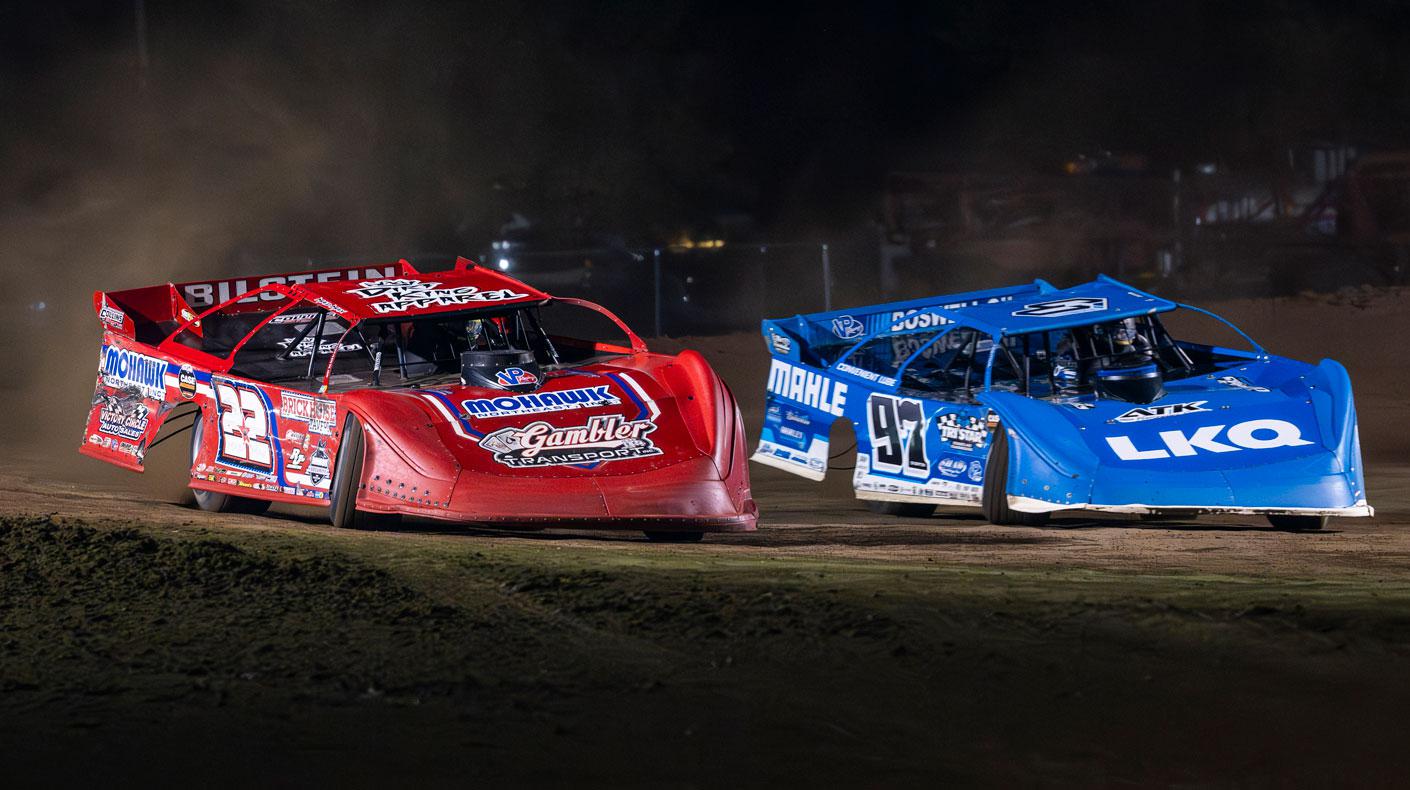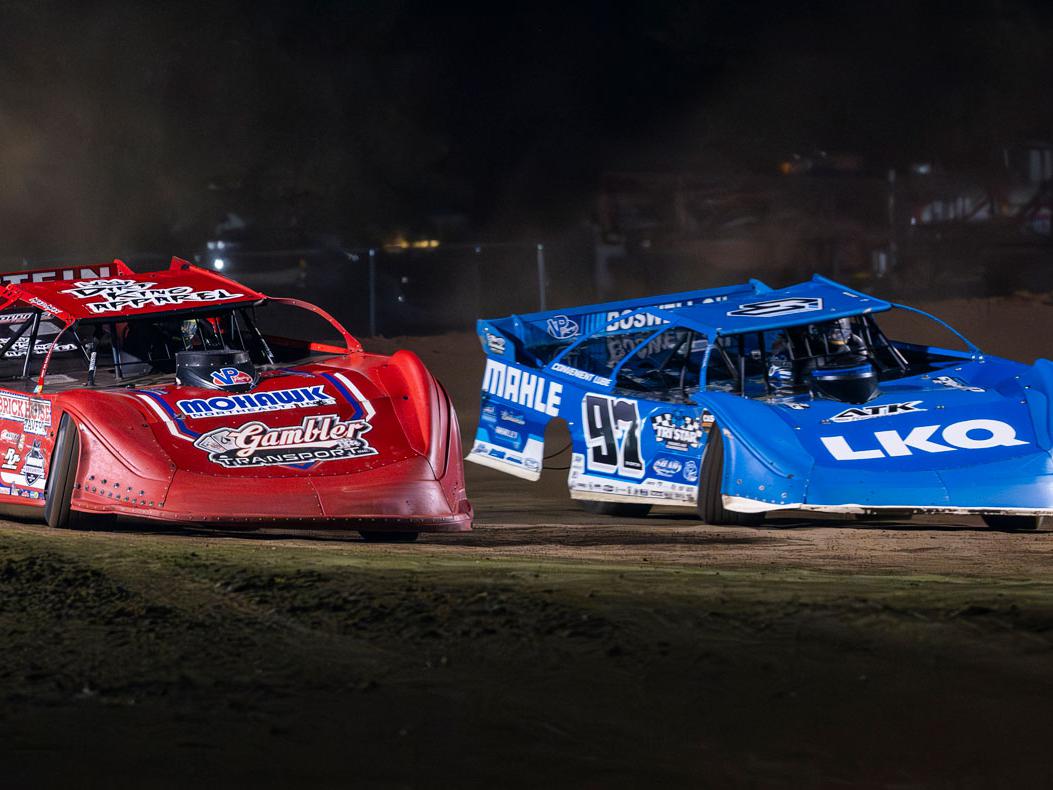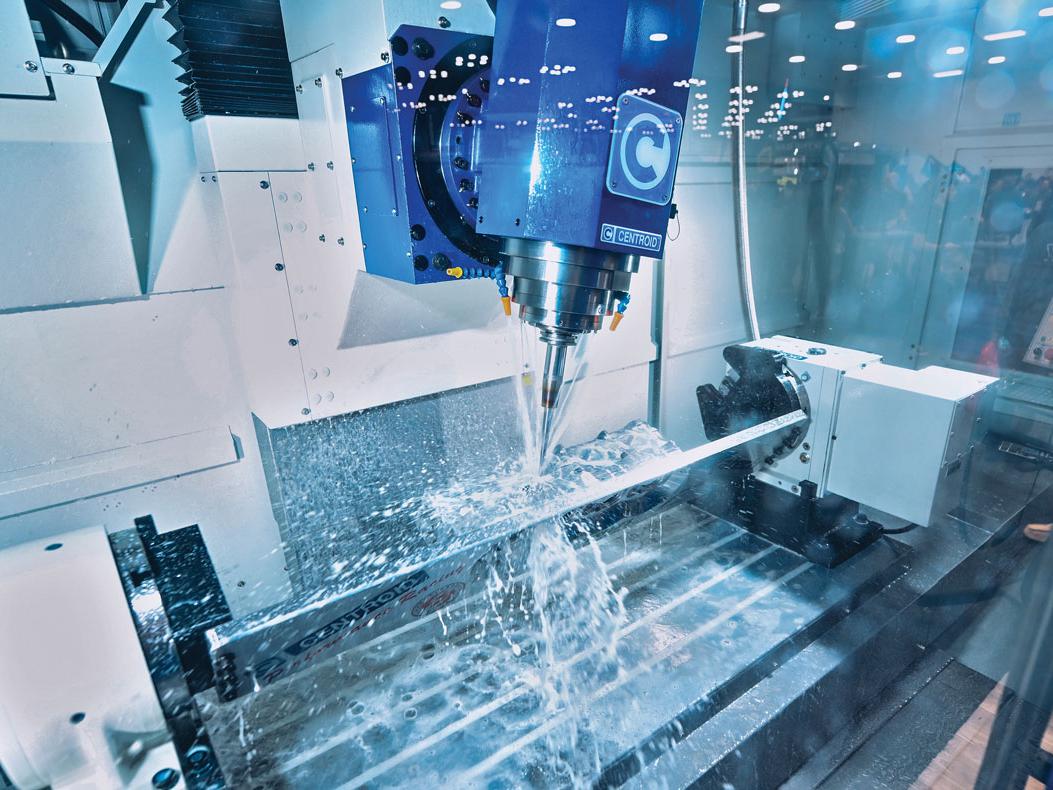Innovation Next: Dirt Late Models

Photo courtesy of World Of Outlaws Real American Beer Late Model Series.
Who sets the pace toward advancement? Dirt late model racers or the rulebook?
In 2015, Jonathan Davenport outperformed the competition in the Lucas Oil Late Model Dirt Series. Race teams and sanctioning bodies tried to understand how. Kevin Rumley, lead engineer for the No. 6 race car, produced a precarious piece of dynamic, non-electrical technology that was believed to have allowed the driver side rear wheel to articulate laterally under specific forces or dynamic attitudes. The theoretical outcome would result in an increase of the race car's lateral footprint and aero stability, which allowed the race car's nose to maintain a downward pitch. This pitch created positive airflow over the body and reduced provisional aero stall.
News spread quickly, and race teams wanted to understand exactly how Rumley and Davenport were able to obtain such an advantage. Tech inspection eventually removed the piece of equipment so officials could inspect the odd piece of engineering.
Confused and curious, the dirt late model community shared snuck images taken of the equipment, and shortly after the community applied the moniker "The Device" to Rumley's mysterious invention. Fortunately for Davenport, he was granted approval to race the rest of the season with the use of "The Device" as it had not broken any rules—the assist was mechanical or hydraulically driven, rather than the illegal use of any electronic assisted components. However, the following season, the precarious piece of race engineering was no more.
To this day, Rumley won't publicly explain what their odd piece of equipment was or how that inflated their advantage against the competition during that infamous 2015 domination. Only one aspect is definitively known about that year: Davenport won 22 races, six of which were consecutive, and won nearly every major dirt late model "crown jewel" race, inevitably winning the 2015 Lucas Oil Late Model Dirt Series championship.
Innovation is the byproduct of steep competition, when racers need to be faster than the rest. While speculation tends to draw conclusions quaintly around a "common sense" position, such as, "Davenport and Rumley were 'cheating,'" many said otherwise. Often in the arena of racing, a gray area rulebook persists hand in hand with innovation, and racers in the 2015 season were reported to have asked Rumley how they could get their hands on this device for their own race cars. Seemingly, rather than condemning Davenport or Rumley as unethical, the dirt late model community reflected a sentiment closely akin to a "Ricky Bobby" position: "If you ain't first, you're last."
While "The Device" and Davenport's dominance stole the dirt late model headlines in 2015, what has been on the leading edge of innovation since then?
"Right now, I think the last couple of years we've really seen a focus on the chassis itself," said Adam Lambert of Penske Racing Shocks, Reading, Pennsylvania. "Longhorn Chassis has been revolutionizing the way the chassis are built. They definitely took a step back and looked at it from a NASCAR standpoint and said, 'How are these NASCAR teams doing it?' It's just much more organized—I think they're finding ways to build and make those processes more repeatable.
"These guys are coming with the complete car, full chassis, bump stops, everything," he continued. "We'll [Penske Racing Shocks] go through and do just like we do in NASCAR and conduct a full pull-down test and measure the entire car itself, looking at load traces, profiles, while looking at your bump steer, caster, camber gain—all that."
This trending approach to dirt late model builds has been sweeping the industry for the past few years. Lambert said implementing new theories and forms of telemetric data from the likes of 3D modeling, computational fluid dynamics (CFD), and the use of K&C rigs has changed the nature of competition. Kinematics and compliance rigs simulate suspension loads, "and can actually look at the exact movement of the car through certain frequencies, and can simulate the deflection of the chassis itself, because in the end the chassis is just a big spring," he explained.
Aerodynamics is the best form of grip, and Lambert suggested, "if you can find an aero advantage, it's really free grip. If you gain an extra 10 or 20 pounds of aero, it's just better, and it's never going to hurt you." Simulating aspects of aerodynamics through the likes of CFD and 3D modeling has assisted in innovation taking place in dirt late model racing and is increasing the overall competition and speeds, mirroring similar results that have equally come to fruition in other forms of racing like NASCAR, IndyCar, F1, and IMSA.
The Big Argument
While Lambert shares his perspective of aero only helping, never hurting, and competitiveness rising as a byproduct, can innovation actually tamp down competition? Lambert expressed the "big argument" that tends to surface when discourse surrounding aero gains prominence in the dirt late model community.
"When you start to have rules that come in that try to put you in a box and say, 'Here's where your spoiler has to be. Here's where your decklid has to be. Here's where your nose has to be,' it does start to put you into that box.
"The dangerous part of that is, the more aero-dependent the cars are, the harder it is to run side by side, because now your aero advantage really goes away when you start to follow another car."
Lambert expanded on his position about aero-dependent races as he recalled, "F1 has the same problem." The drag reduction system (DRS) on a rear wing creates huge advantages to leveraging clean air for more grip and diminshes the ability to race side by side. Without these types of innovation, "it's just follow the leader because clean air just gives you so much more grip."
Bill Schlieper of Pro Power Racing in Sullivan, Wisconsin, shared his perspective of innovation with aero in dirt late models. Going one step further, he explained, "The next innovation is going to be trying to figure out how to make it so that we can race in traffic, and we can race up behind people, because we've become so aero dependent. Many times in the old days, you could actually race your way into a feature and still have a plan of winning or coming through and getting a top five.
"The trend to winning in dirt late model right now seems to be the aerodynamic friendly bodies."
On the contrary, Schlieper explained, "they [dirt late model cars] are so twisted that the right rear is touching one side of the trailer, and the left front's rubbing on the other side of the trailer. Those things have happened over time—they just need to get it under control. We end up with those changes that have been made, and many local drivers have, basically, a worthless car because they don't have that body.
"As time goes on, many local drivers end up not having a chance or an opportunity to even race for a win, much less go to the races," Schlieper expressed.
Innovation or Impediment?
To culminate or propel innovation forward in the field of dirt late model racing, race programs, including the likes of chassis/engine/suspension builders, must stay within the guidelines of that particular sanctioning body's ruleset. The rulebooks of prominent dirt late model series are meticulously put together to create safe, exciting, and fair race guidelines predicated on past events, advantages, or disadvantages witnessed throughout each season. Much credit is deserved by these associations, as the rules are often designed from feedback heard and felt by racers, fans, experts, and other stakeholders that subscribe to the races.
"Rules are the most significant constraint. While this market is generally less price-sensitive than others, overly restrictive or reactionary rules can stifle creativity and ironically, increase costs," said Aaron Morey of Bilstein Motorsport's American headquarters in Poway, California.
Morey cited the "droop rule" as a post-COVID-19 mandate that created a large buzz throughout the dirt late model community. This mandate occurred in national series—which smaller race series tend to draw from for their rulebooks—and created a rule for a fixed droop limiter on the left rear suspension. "Effectively requiring everyone to run a 1-inch bump stop. This regulation rendered our existing droop limiter—which provided critical compliance and dynamic support—noncompliant," described Morey.
Changes like the "droop rule" affected the dynamic of how the drivers raced, as well as how the actual race car was set up. Mandates that amend previous seasons' rulesets create a wave through the industry that support and innovate the race driver's car and program. "We had to invest significant resources to recover the performance through alternative means," Morey continued. "That's the balancing act: Rules are intended to create parity and manage costs, but they can also eliminate well-engineered solutions and force a reset in development. True innovation thrives when there's enough freedom to explore new ideas—especially in a technically driven sport like this."
Morey stated, "Our job is to work within those boundaries while still pushing performance forward."
Sharing this perspective, Lambert sees the challenge as an opportunity that "makes you have to navigate" the full scope of where innovation may sprout. "You definitely want to help the series out with trying to understand what they're trying to do. But then obviously the racers are our customers. Our job is to help our racers win, trying to find where that next advantage is."
Rules Implementation
If innovation seems to exist and has the ability to thrive, is the inconsistent implementation of the rules stifling innovation in dirt late models?
Mike Nuchols of Warrior Race Cars in Seymour, Tennessee, suggested, "…Money, but not really money."
He explained, "Our sport, on its highest level, we're able to do whatever we can pay to do. Essentially, our rules really aren't dictating things to hold us back. Our rules are restricted, but our rules are still really wide open at the same time…. The only thing that dictates innovation or what we can or can't do is just how much money we want to spend. That's pretty much what it boils down to."
Nuchols' position establishes a paradox that often supports the seeds of change within racing regulations. However, many other genres of racing will have a spending cap delineated in the rulebook. Lacking a definitive cap allows a team with a more robust budget to inherently increase the odds of discovering finite advantages through its vast network of sponsors, builders, or engineers. CFD, wind tunnels, pull down rigs, spring smashers, etc. are all invoices that emerge as resources for a team. Are these aspects necessary? Difficult to draw a hard line, as the access exists for anyone and everyone—permitted the budget aligns.
For racers operating in the perfect zone of compliance within the boundaries of regulation, the advantage can be huge. Their innovations, like "The Device," for example, are yet to be considered non-compliant. What is allowed in racing and what is practiced aren't always congruent.
"There are tons of gray areas in our sport. Our sport is very backwards right now. The way I look at our sport is—in the super late model ranks, which is the highest horsepower, they have the most stringent rule package, and tech process is way more stringent there than it is at its lower levels," Nuchols explained.
Rules, as Nuchols alluded to, ensure that at the highest echelon of racing doesn't get out of control, as he exemplified the hypothetical scenario: "I for one know I can bolt on probably 75% of the stuff that's deemed illegal in the highest level, and I can go to a regional show this weekend, and it will not be caught."
Evaluating the landscape of the dirt late model series, the highest echelon must enforce the rules, as they have the bandwidth to do so. Aspects like "car counts and lack of employees" are components that contribute to the relaxed position smaller series may have. "Say you go to a [super dirt late model] event and you got something wrong. They [tech inspection] can chuck you out because there's 50 more of you sitting there waiting to go," Nuchols stated. "You go to a regional race, and there might be 17 cars there, and they need to put on a good show. They're not going to chuck four people out for having something goofy. Employee wise, most of these series don't have enough employees to have a stringent tech."
Nuchols cited "goofy little suspension tricks" that the community has "created over the years in the industry" as advantages within the "gray area" of racing. These tricks "cost a little more money and make the ride a little better," but stringent tech inspections at professional levels would eventually deem these aspects illegal. This occurs at the highest echelon of dirt late model racing, and these advantages "are forbidden at the very top," but they will end up trickling down and be used "on the lower-level cars, which is backwards."
"The lower-level guy can have that couple-thousand-dollar part that we're not allowed to have on the highest level. In turn, it makes the lower-level guys' cars more expensive," he pointed out.
Is this outcome positive if lower echelon builds increase cost and are deemed illegal by the top divisions they are looking to rise to?
Nuchols said, "If we start playing in the gray area, they just don't like it and tell us we can't do it anymore, instead of it just being a gray area and letting us try to explore that stuff."
Sanctioning bodies are protecting competition by attempting to have rules that "keep an even playing field." These contingencies are set in place to ensure the higher echelons of dirt late model racing can stay regulated. Nuchols explained, "They're not paying attention to the lower levels, and it's getting out of hand on the lower level."
The major dirt late model series range from 20-plus to 40-plus events in one season. Many racers overlap their events across different sanctioning bodies across multiple states. Often, 90-plus nights of racing may occur, then consider maintenance, preparation, testing, and of course, racing.
"I think what's holding it back, really, is the amount of racing they do," shared Lambert.
"Well, to tech and police these cars the way they need to do is physically impossible to do," stated Steve Baker of Rocket Chassis, Shinnston, West Virginia. He explained the constraints of time as an integral yet overlooked factor for the rulebook. "We need to keep the rules as simple as possible. It's really tough to tech cars and keep things under control. There's 30 people against one tech guy, and you're only there for a few hours.
"Then there are some places you go where there's no tech at all," he continued. "They just let you know whatever happens, happens—so that's definitely an issue."
Sharing Nuchols' sentiment, Baker also suggested the ""places"" that seem to have the least amount of rule enforcement occur at the lower echelon of racing.
Whether it's the confines of rules intended to even a playing field, time, or money, dirt late model racing continues to push for innovation and safe racing above all odds. Baker voiced the importance of effective regulations for all drivers when he stated, "We have car owners in the top divisions who put a lot of money into it, and that leaves the local racer behind. That gap is getting bigger between a local racer and the professional race teams."
To read more like this for free, sign up for a digital subscription to PRI Magazine on Zinio here.
Once you download the Zinio mobile app or are logged into Zinio on a desktop browser, you will gain immediate access to more than a year's worth of content, including "Innovation Next: Dirt Late Models" here and machinery coverage in the August 2025 issue here.
SOURCES:
Bilstein Shock Absorbers
bilstein.com/en-us/
Penske Racing Shocks
penskeshocks.com
Pro Power Racing
propowerracing.com
Rocket Chassis
rocketchassis.com
Warrior Race Cars
goddardwarrior.net
 MEMBERSHIP LOGIN
MEMBERSHIP LOGIN JOIN PRI
JOIN PRI


